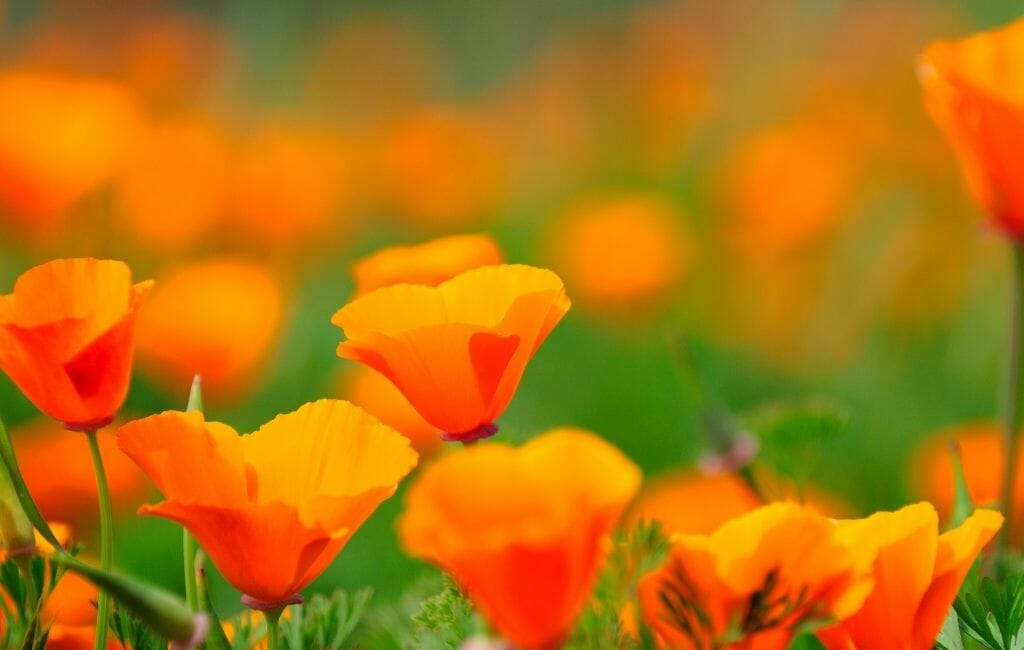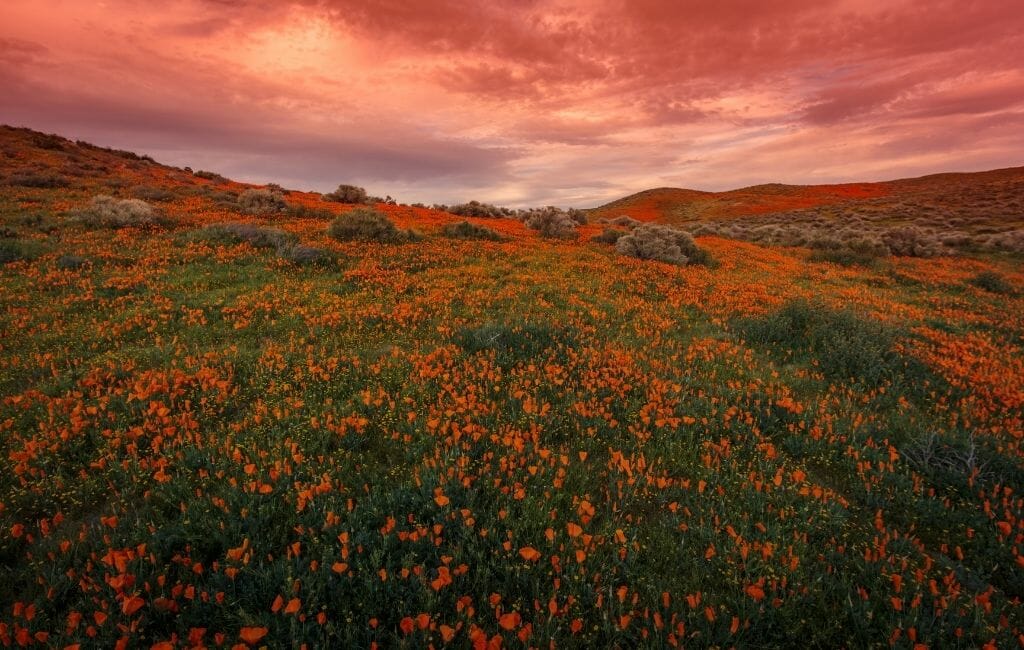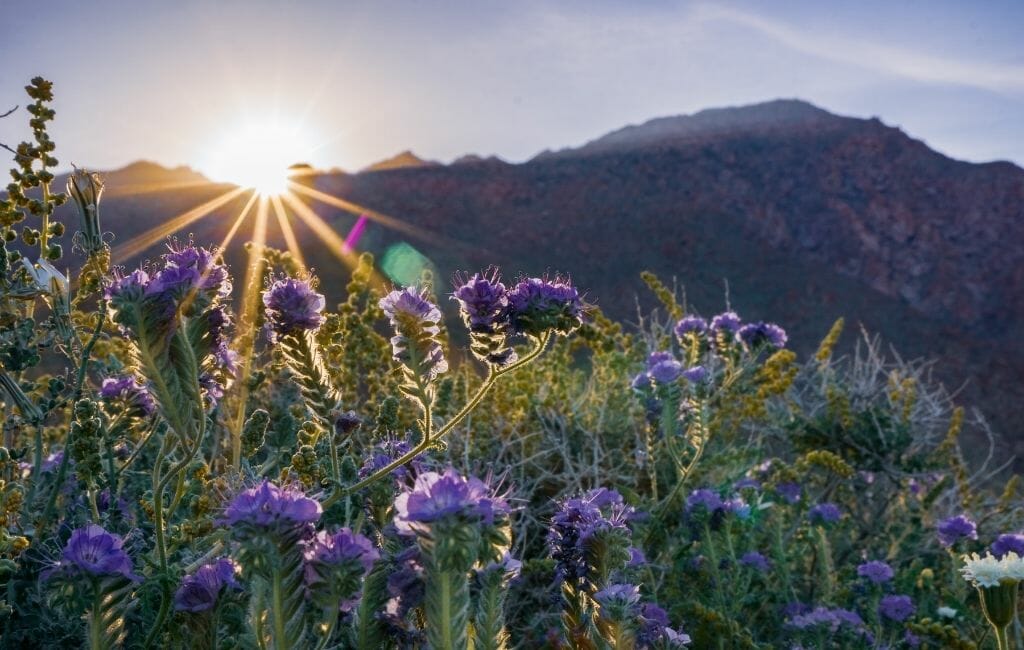California’s superbloom is so big and bright, it can be seen from space
On March 2, 1903 the California poppy, Eschscholzia californica, became the official state flower of California (Ca. Government Code Section 421(opens in new tab)). The plant’s bright orange flowers are an unmatched symbol of the Golden State, perhaps viewed as a floral representation of the “fields of gold” sought during the gold rush. The California poppy is commonly seen blooming in the spring and summer along country roads and freeways throughout much of the state, making this plant a highly recognizable symbol of California, and April 6 of each year is officially designated as California Poppy Day.
It is often believed that there are laws prohibiting the cutting or damaging of the California poppy because it is the state flower. While there is no law protecting the California poppy specifically, California Penal Code Section 384a(opens in new tab) requires written landowner permission to remove and sell plant material from land that a person does not own, and removing or damaging plants from property that a person does not own without permission may constitute trespass and/or petty theft. However, these laws do not prevent the collection of California poppies on private land by the landowner. California poppies are a beautiful and easy-to-grow addition to your garden, and although you may choose to pick them from your property, they last much longer in the ground!
California’s superbloom phenomenon is so big and bright this year it can be seen from space. NASA’s Landsat 9 satellite, which was launched in 2021 to capture images of Earth’s land surface, sent back images of bright purple and green blooms in Carrizo Plain National Park.
A superbloom occurs when desert areas in Southern California receive more rain or cooler weather through the fall and winter, allowing more flowers to thrive. The term “superbloom,” however, is not a scientific one: It was created by the media to describe these colorful, robust blooms, said said Cameron Barrows, an associate research ecologist at UC Riverside’s Center for Conservation Biology.
Some years, the blooms aren’t that super. Excessive rain can also help bromes, a type of grass. grow fast, filling the area and covering the flowers, said Richard Minnich, a professor of earth sciences at UC Riverside.
And it’s not every year the area gets enough rain for the spectacle to happen. The 2023 NASA images, taken on April 6, are much more colorful than the April 2022 images, NASA says. Carrizo Plain National Park is located north of Santa Barbara.
The 2019 bloom near the town of New Cuyama was also visible from space, according to NASA. Several areas in the state are experiencing superblooms this year, with Chino Hills State Park getting a carpet of orange poppies.
Visitors often flock to the superblooms when they are vibrant, and officials have called excessive tourism a “nightmare” in the past. “The 2019 bloom became a national … and international phenomenon,” Lake Elsinore Mayor Natasha Johnson said during a news conference earlier this month. “Numerous problems occurred on our trails and roads. There were Disneyland-size crowds wanting to see the poppies.”\23
Some visitors trampled the flowers and a California highway patrol officer even died as a result of problems with visitors during the 2019 superbloom, according to the Regional Conservation Authority of Western Riverside County. Trails, parking and access to Walker Canyon were closed as a result.
The 2023 bloom was not expected to be as vibrant and vast as the one in 2019, but it was expected to be large, Johnson said. Visitors were urged to watch it from a safe distance – on a livestream of the area, as they will not be allowed in Walker Canyon in Lake Elsinore. source
California’s wildflower ‘super bloom’ transforms landscapes into paintings
Southern California is enjoying a wildflower “super bloom” after years of extreme drought.
The state had been under a drought state of emergency since 2014, but Gov. Jerry Brown lifted the order for all but four counties, earlier this month.
The wet winter strained reservoirs to the max and replenished mountain snowpacks, which are now at 164 percent of the season average.
Photographer Sarah Chah spotted a group of pronghorns, sometimes known as the American antelope, in the Carrizo Plain National Monument, about 100 miles northwest of Los Angeles.
The Temblor Range, a famous spot for wildflower viewing that’s part of the Carrizo Plain, is now carpeted in blue, purple, orange and yellow flowers and vibrant green foliage.Another visitor to the region, Heather Lomax, tried out her new drone camera last weekend during a camping trip and saw yellow flowers for as far as the eye can see.The Theodore Payne Foundation for Wild Flowers and Native Plants, in Sun Valley, has a wildflower hotline that’s updated every Friday during the season. It’s narrated with gusto by Emmy-winning actor Joe Spano (of “Hill Street Blues fame), which makes it worth a listen, even if you’re not heading to the area.
April and May are prime times for seeing the wildflowers before hot weather hits.
The Bureau of Land Management, which oversees the monument is asking people to share their photos with the hashtag #trackthebloom. source
Where to See California’s Super Blooms
Wondering where to experience the most eye-catching wildflower blooms in California? Feast your eyes on these vibrant areas in California.
Ever thought to stop and smell the flowers? California’s super blooms are the ideal colorful displays to enjoy the wonders of nature. Observe mountain ranges transforming into surreal orange canvases—floral brushstrokes of yellow, green, and purple paint the landscapes and illuminate the panoramas. You’ll discover that the hot orange of the poppies in contrast to the browns of desert bushes yields a blissful sight to see. Pair that with the dramatic blue of the clear skies above and you got yourself a pretty paradise.
Wondering where to experience the most eye-catching wildflower blooms in California? Feast your eyes on these vibrant areas in the Golden State.
THE CALIFORNIA POPPY SUPER BLOOMS YOU WON’T WANT TO MISS

MURRIETA
Is there anything more stunning than Murrietta’s palm tree-lined streets and spectacular sunny weather? How about a fresh rainbow pop of color brought to you by the dazzling bloom of wildflowers?
That’s what you can expect when spring arrives in Murrietta. Rainfall, cool winds, and local ecology come together to put on a colorful show for all to see. Evening primrose, verbenas, poppies, desert lilies, and plenty of other colorful wildflowers provide a front-row seat to nature’s splendor.

Best Places to See the Super Bloom & Best Time to Go!
The United States has some of the most spectacular wildflower super blooms in the entire world. Spring wildflowers emerge across the coastal valleys of the west, mountainsides and even in the harsh desert environments of some of our National Parks. But, did you know a super bloom does not happen every year?
We’ll share with you all the details of how and why a super bloom takes place. As well, we’ll share amazing super bloom locations and when the time to see them!

This post contains affiliate links to help run this site at no extra cost to you so we can keep providing FREE Outdoor, Camping, RV and Travel information, advice and tips. Full disclosure here.
What is a Super Bloom?

A super bloom, also spelled as one word “superbloom”, is a rare desert botanical phenomenon in which an unusually high proportion of wildflowers whose seeds have lain dormant in desert soil germinate and blossom at roughly the same time in the spring and even into the summer.
What dictates whether a Super Bloom will occur
For a wildflower super bloom to occur, weather and environmental conditions have to be just right. A good wildflower bloom depends on at least 3 elements.
First, there must be well-spaced rainfalls throughout the late Fall, Winter to very early Spring seasons. The foliage and flowers in the desert must receive ample water accumulation to penetrate deep into the soil to reach the dormant seeds.
Second, in addition to ample precipitation, there must be warm (not hot) temperatures leading up to the super bloom. The warmth from the sun help germinate the seeds to promote growth
However, that said, too much rain causing flash floods will wash away the seeds before they’re able to take root.
Third, there can’t be any dry winds or hot baking sun to hinder seed sprouts and plant growth.
But, on the opposite spectrum, if the Fall and Winter seasons experience drought, the seeds will perish from dehydration.
One other environmental concern that may hinder a super bloom is if there are too many invasive plants that rob the germinating seeds of their much needed moisture and soil nutrients.
How often does a Super Bloom happen?
As you’ve just read, environmental and weather conditions must be perfectly aligned for a super bloom to occur. That is the reason why they don’t happen for consecutive years.
In California, a wildflower superbloom will only occur once every 10 years. 2019 was the last super bloom in the Golden State.
And, in Death Valley, you’re lucky to see a super bloom anywhere from 10 to even up 15 years.
How long does a superbloom last?
Typically, if the conditions are ideal and depending on elevation, the wildflower super bloom season in the desert southwest region starts around mid February and can last all the way until June to even mid July.
However, peak season of the super bloom usually happens in early spring. Typically in March and April.
Why super blooms are necessary
Super blooms are vital to the balance of nature. With the mounds of flowers come lots of bees, butterflies, hummingbirds and other pollinators that are needed to continue the life cycles of plants and trees.
Where do Super Blooms occur?
Super blooms predominantly take place in the grasslands and deserts of Southern California into Arizona. Larger concentration of blooming flower fields have actually been seen from space! These massive flowering events last up to 2 months.
So, now that we’ve learned how superblooms occur, let’s check out the best places to see the super bloom in the U.S.!
California’s Rare “Super Bloom” Is Moving North Into the Central Valley

Bob Wick, Bureau of Land Management
California’s rare “super bloom” is migrating north into the Central Valley, according to an Instagram photo the Bureau of Land Management posted yesterday. Up until recently, the spectacular display of spring wildflowers has been concentrated further south in California in places like the Anza-Borrego Desert outside of San Diego and Walker Canyon near Los Angeles.
“The show is simply indescribable at the Carrizo Plain National Monument,” Bob Wick of the Bureau of Land Management wrote in the caption that accompanied his photo.
The valley’s hills are covered in large swaths of purple and yellow flowers, which according to Wick, are “coreopsis, tidy tips and phacelia, with smaller patches of dozens of other species.”
“I have never seen such a spectacular array of blooms,” Wick said. “Ever.”
Carrizo Plain National Monument is one of the best-kept secrets in California thanks to its remote location in the Central Valley, but that’s not preventing flower-seekers from making the three-hour drive from Los Angeles to see incredible vistas like these.If you plan on visiting Carrizo Plain National Monument during the super bloom, be sure to follow the Bureau of Land Management’s tip and come with a full tank of gas since the monument is in a remote location without service stations. Call (805) 475-2035 for updated flower reports. source










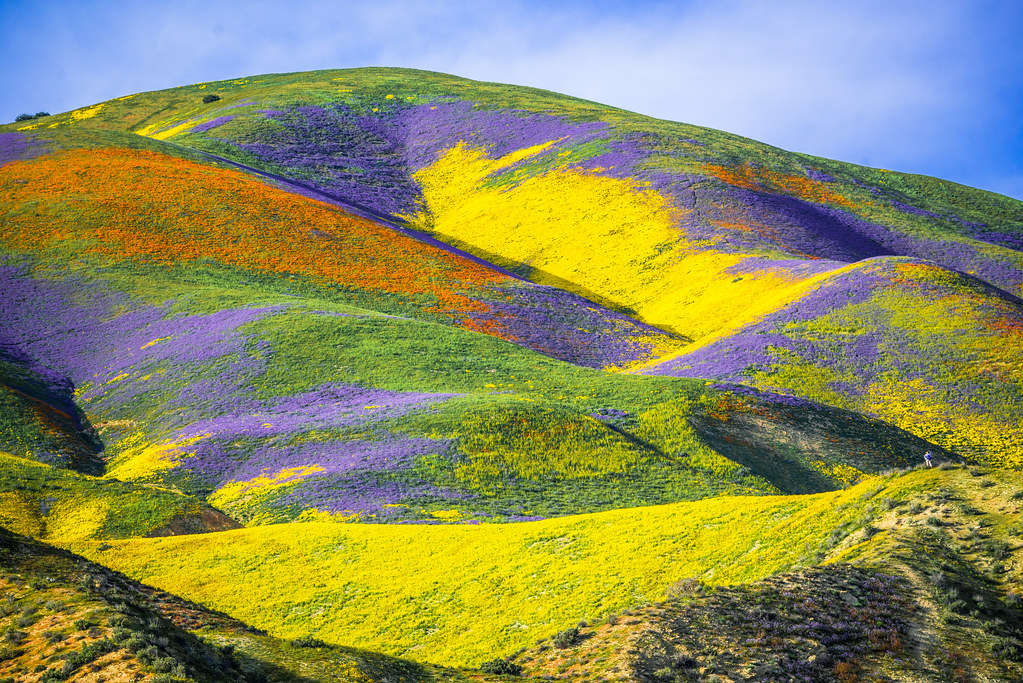







Best Places to See the Super Bloom in the U.S. & When to Visit
Anza Borrego Desert State Park – California

One of the best best places to see the super bloom is Anza Borrego Desert State Park located in southeast California. Having experienced this particular super bloom location in 2019, I have to say, “it’s nothing short of show-stopping!”.
Simply put, the vast beauty of the many different varieties of wildflowers and vivid colors makes us wonder how it happens in the desert and even mountain desert regions.
Flowers are found across most of the Borrego area, all but high mountains, rocky hillsides, badlands and some sandy desert regions. Favored locations include:
-
- Borrego Palm Canyon – sheltered canyon with palm trees and many other plants.
- Culp Valley – higher elevation area near the eastern park boundary along S22.
- Henderson Canyon Road – highway northeast of Borrego Springs, passing good wildflower terrain close to Coyote Creek, at the foot of Coyote Mountain.
- Plum Canyon – side canyon of San Felipe Creek Valley, south of CA 78.
Amongst the hundreds of blooming wildflowers in Anza Borrego, you’ll see Bluebells, Brittlebush, California Poppy, Desert Lily, Desert Sunflowers, Evening Primrose, Desert Lupine, Popcorn Flowers, Verbena, Wild Mustard.
And the best part is camping at the Anza Borrego Desert State Park’s Borrego Palm Canyon Campground. As well, Anza Borrego has excellent boondocking spots that we found through RV Life’s Trip Wizard trip planner. Both put you front and center of the super bloom!
Lake Elsinore – California

California is known for its’ amazing wild poppy superbloom. In fact, in 1903, the California Poppy became the Golden State’s official state flower.
In the Spring season, the mountains and hillsides steal the spotlight with their thick and lush hues of golds and oranges. And for decades, it’s become one of the best places to see the super bloom!
In fact, during the 2019 super bloom (and even 2020), the poppy fields at Lake Elsinore’s Walker Canyon Trail were so abundant that they were actually visible from space!
The hillsides east of I-15 in Lake Elsinore exploded with color in late February as a super bloom covered more than 1,600 acres of hillsides in and near the city (and we got to see it!).
The California poppy blooming extravaganza doesn’t happen unless there is ample rainfall preceding the blossom season.
Only then, the golden hues take foothold between starting anywhere from late February all the way into early May; peaking for 3 weeks from about late March to into April.
Since Walkers Canyon and Anza-Borrego Desert State Park border each other, this makes a great super bloom destination to get all the blossoming flowers you wish to see! source
CALIFORNIA WILDFLOWERS 2023 – WHERE TO SEE THE SOUTHERN CALIFORNIA SUPERBLOOM
There’s just something about Mother Nature…and her magnificent California wildflowers. American naturalist John Burroughs once said, “I go to nature to be soothed, and healed, and to have my senses put in order.” How very true.
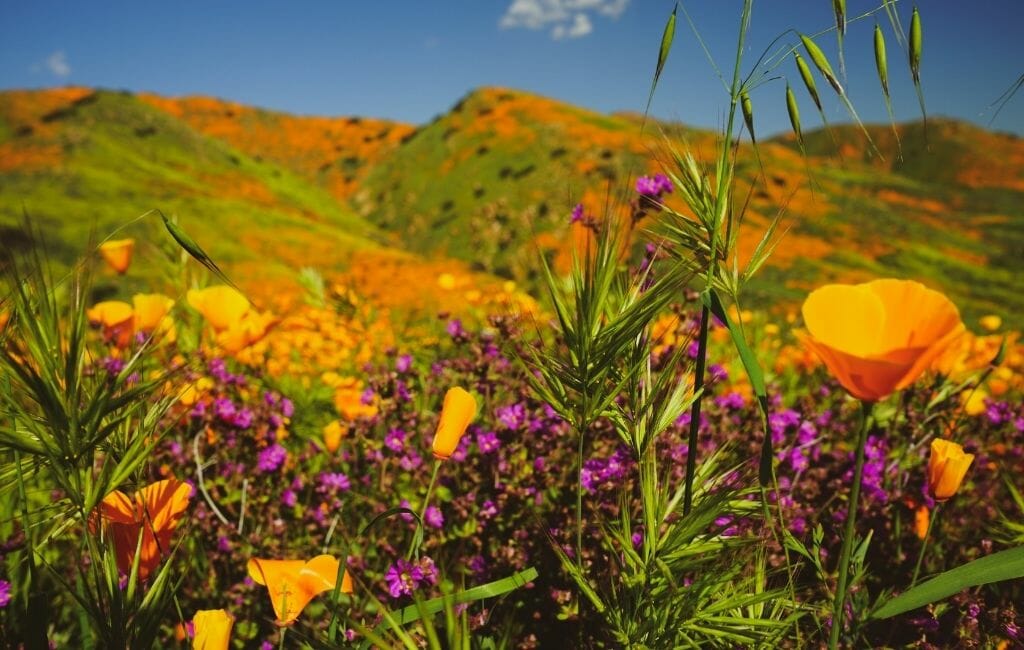
WHEN IS CALIFORNIA WILDFLOWER SEASON?
Spring is an absolutely beautiful time of the year in Southern California. A time when the air is filled with intoxicating fragrances from a host of newly blooming wildflowers in the desert and coastal areas from mid-February through May, peaking in mid-March.
However, this also depends a lot on the rainfall and temperatures of each season and it is hard to pinpoint an exact time. I highly recommend watching the local news channels and checking for current updates on the local California Wildflower bloom, and then acting quickly once the buds are starting to bloom. With all the rain we had in the last weeks, 2023 looks promising for higher than average bloom, maybe even a superbloom? We’ll have to keep watching how the rain continues in Southern California this spring. In any case, it is still worth driving out there and soaking it all in and enjoying nature.
CALIFORNIA SUPER BLOOM
Each year, we botanical lovers hope and wish for a super bloom – when the landscape is covered with a rainbow explosion of colorful flowers. Super blooms happen when a delicate balance of sunshine, temperature, wind, and rainfall has occurred during the fall and winter months, resulting in an unusual number of wildflowers all blooming at the same time.
WHERE TO SEE THE SOUTHERN CALIFORNIA SUPERBLOOM
If you are planning a day trip to see the California Wildflowers, take a look at these Southern California Parks. Most are within a few hours from San Diego or Los Angeles. Make sure to get there early, not only to avoid the crowds but also to get the best light for your photos.
ANZA-BORREGO DESERT STATE PARK
Address: 200 Palm Canyon Dr, Borrego Springs, CA 92004
Website

Located in Borrego Springs in Southern California’s Colorado Desert, Anza-Borrego is the largest of California’s state parks. And it’s also one of the early blooming first-responders of our desert regions with over a hundred varieties of wildflowers and blooming cacti.
This magnificent outdoor playground just two hours east of San Diego sports hiking trails, campgrounds, waterfalls, Desert Bighorn sheep, and of course, wildflower preserves. Though the bloom officially begins halfway through February, mid-March is typically the best time to see the spectacle of color carpeting the desert floor.
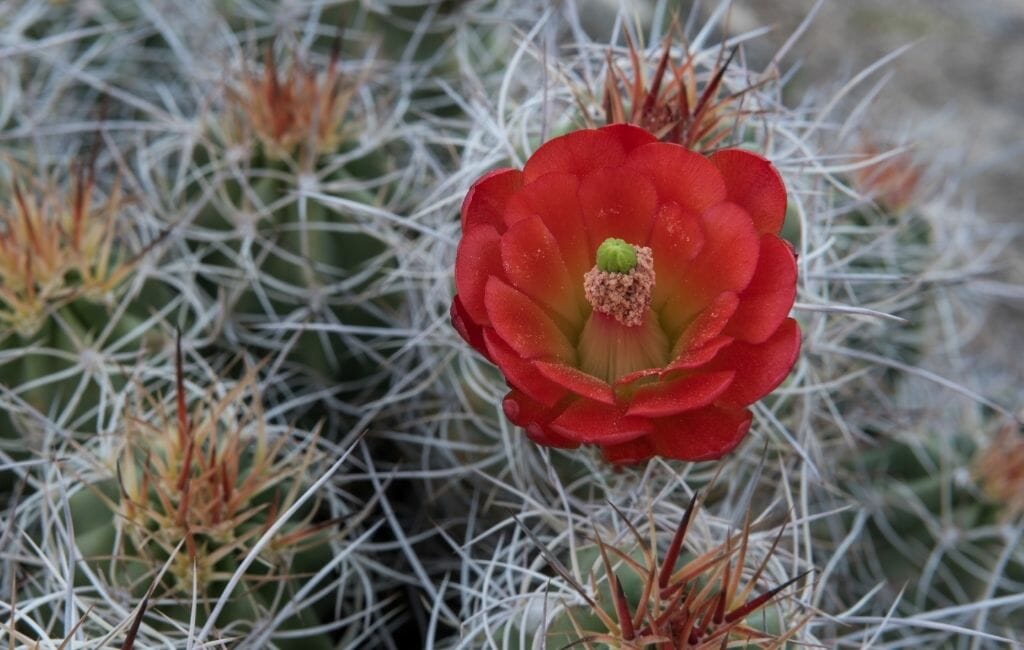 Best places to see a variety of desert blooms, including the bright pink-purplish sand verbena are along Henderson Canyon Road, surrounding the Visitor Center, and Borrego Palm Canyon. It’s simply magnificent.
Best places to see a variety of desert blooms, including the bright pink-purplish sand verbena are along Henderson Canyon Road, surrounding the Visitor Center, and Borrego Palm Canyon. It’s simply magnificent.The intense blooming season occurs in late winter to early spring, mid-February through mid-May. Taking to the trails is the ideal way to see the poppies, and how amazing that one of its trails is actually wheelchair-accessible.
JOSHUA TREE NATIONAL PARK
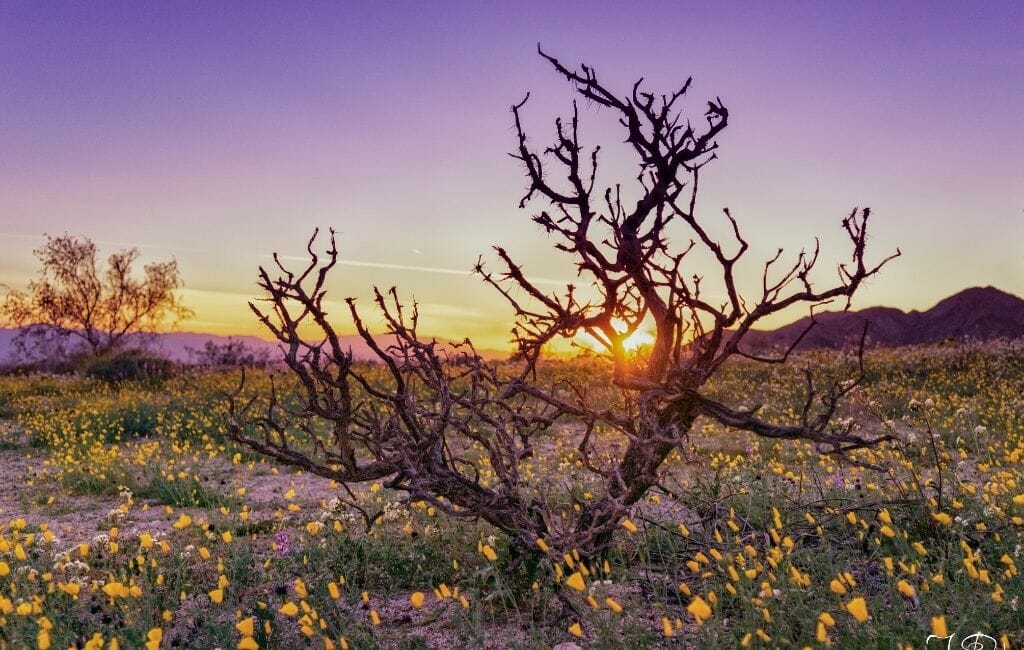
One of the west’s most picturesque national parks and one of our favorites, Joshua Tree encompasses 1,200 square miles within the Colorado and Mojave Deserts. Though the park is a popular year-round destination, spring’s colorful blossoms make a visit here a prized experience.
Wildflowers can begin blooming in the lower elevations in February, and in higher elevations in March and April as daytime temperatures rise. The park showcases the most variations of splendid color ranging from reds and yellows, to purples and blues– all splashed across a fascinating and picturesque landscape.
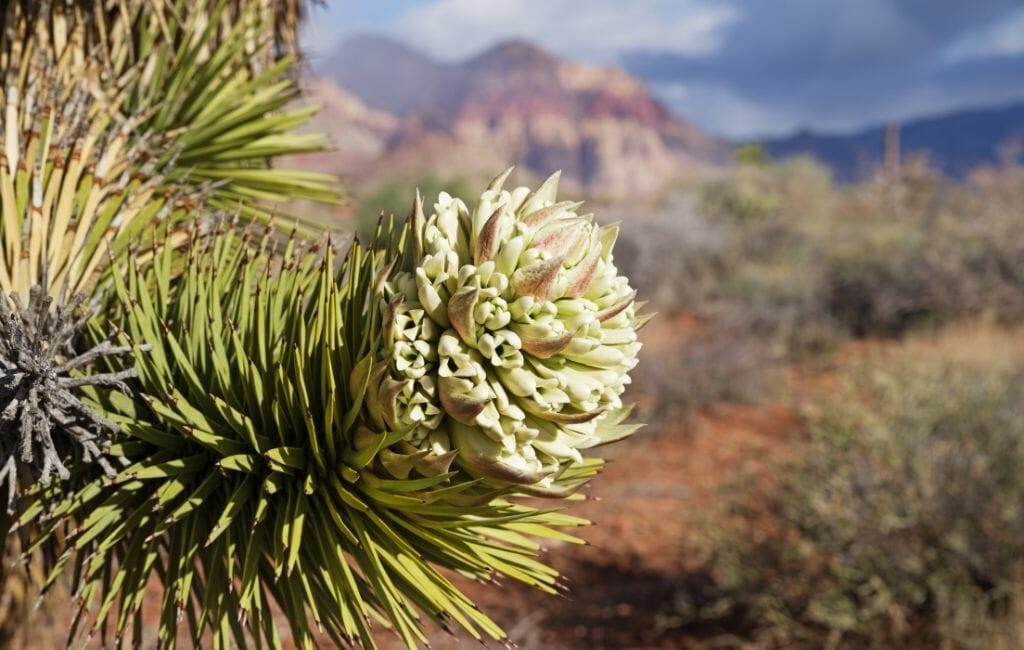
You’ll find stunning Mariposa and Desert Lilies, vibrant blue Canterbury Bells, Purple Mat, and bright Golden Poppies here, just to name a few. It’s more than worth the three-hour road trip from San Diego.
WALKER CANYON, LAKE ELSINORE
UPDATE: Walker Canyon was closed on February 7th, 2023 for visitors for the duration of the poppy bloom.
Just one-hour northeast of San Diego, Lake Elsinore is the largest freshwater lake in California. It also achieved notoriety as the epicenter of the 2019 super bloom in its magnificent ecological reserve, Walker Canyon.
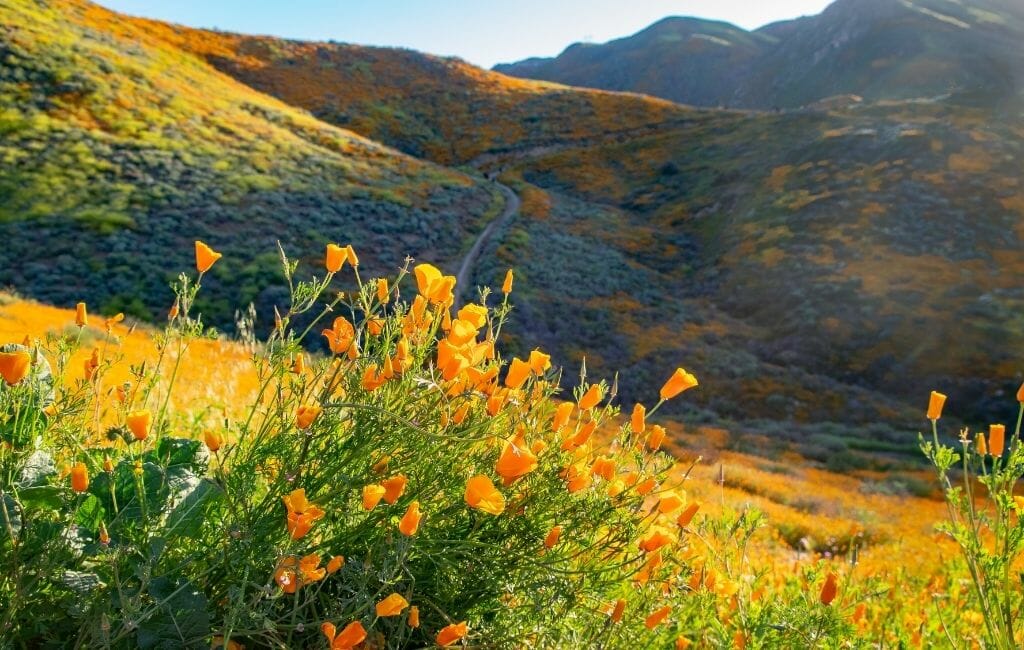
Multiple trails traversing this high-desert canyon in the Temescal Mountains of Riverside County lead to rolling hills blanketed with an explosion of rich colors from Golden California Poppies, Desert Sunflowers, and more, though the poppy fields reign supreme. Their season of wildflower blooms typically runs from early March through early April, depending on weather factors.
CARRIZO PLAIN NATIONAL MONUMENT
Nestled in California’s Central Valley, 100 miles northwest of Los Angeles, this monument area is all that remains of the immense grasslands that once covered this expansive picturesque valley.
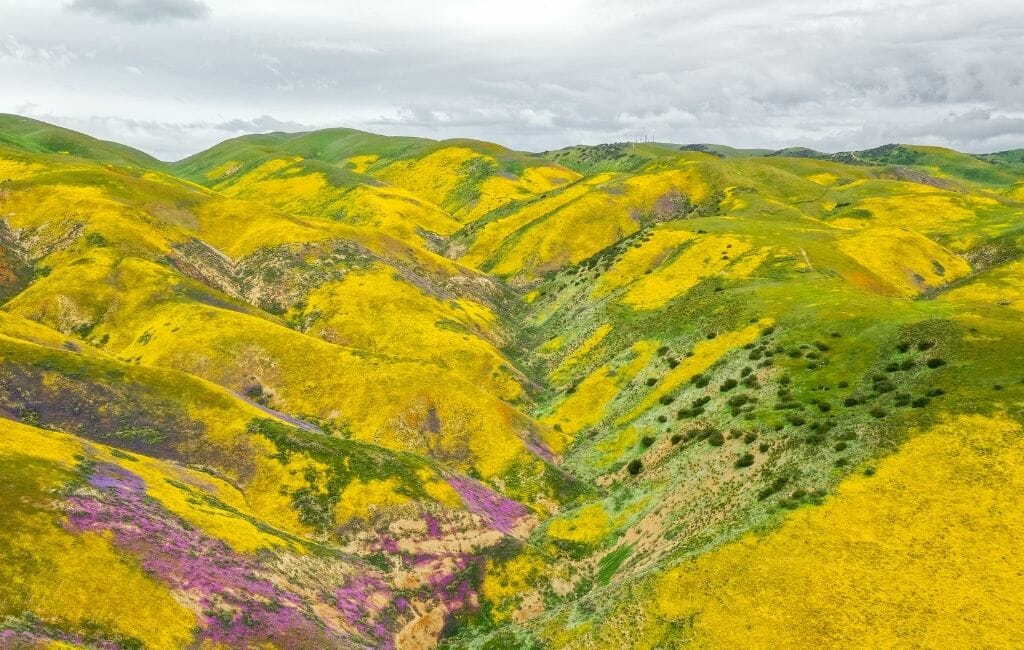 Rolling hills and meadows here as far as the eye can see are blanketed in larkspur, phacelia, daisies, and Mother Nature’s other jewels flashing orange, bright yellow, and purple hues. Peak bloom typically runs from late March through the end of April.This wildflower region is in the middle of nowhere. There are some Airbnb’s in a small town called McKittrick, but if you want to stay in a larger town, you can either stay in Pismo Beach (81 miles) or Bakersfield (69 miles). I personally would choose Pismo Beach, a cute little Central California beach town with a fun vibe.
Rolling hills and meadows here as far as the eye can see are blanketed in larkspur, phacelia, daisies, and Mother Nature’s other jewels flashing orange, bright yellow, and purple hues. Peak bloom typically runs from late March through the end of April.This wildflower region is in the middle of nowhere. There are some Airbnb’s in a small town called McKittrick, but if you want to stay in a larger town, you can either stay in Pismo Beach (81 miles) or Bakersfield (69 miles). I personally would choose Pismo Beach, a cute little Central California beach town with a fun vibe.
LAGUNA COAST WILDERNESS PARK
Address: 18751 Laguna Canyon Rd, Laguna Beach, CA 92651
Website
A 7,000-acre wilderness area in the San Joaquin Hills surrounding Laguna Beach, this picturesque park features coastal canyons, stunning ridgeline views, and the only natural lakes in Orange County. Streams running only in the spring are also a huge draw.
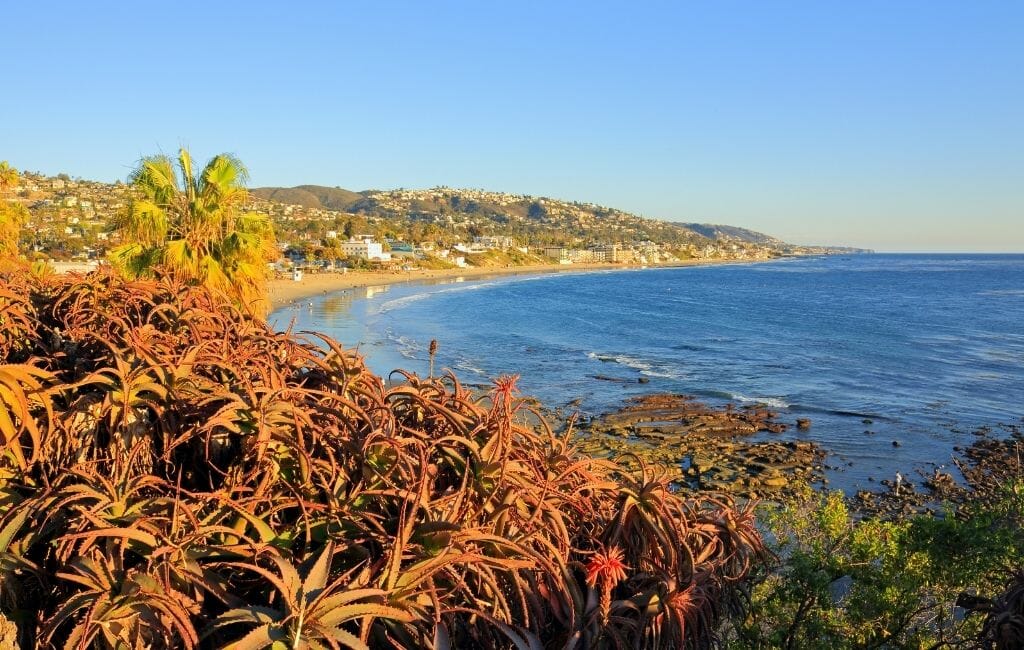
We also love that this pristine nature park transports visitors back to how coastal California appeared many years ago. Forty miles of trails meandering these untouched canyons lead hikers and bikers through oak and sycamore woodlands and onto elevated ridges with panoramic vistas.
Native plants and flowers such as wild hyacinth, morning glories, popcorn flowers, and southern sun cups are joined each spring by Baby Blue Eyes, vibrantly violet Johnny Jump-ups and Mariposa Lilies. Wildflower season typically peaks here the end of April.
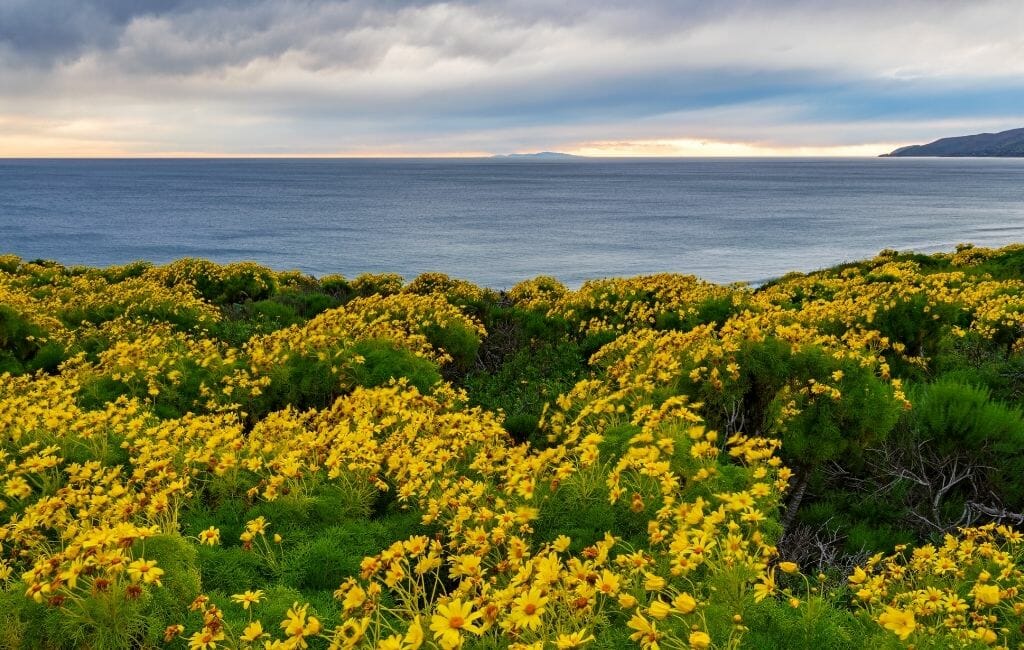
This promontory located just west of Los Angeles forms the northern end of the Santa Monica Bay, and is yet another magnificent California state park offering amazing picturesque hiking. On a clear day you can see all the way to Santa Catalina Island. And how awesome that these vistas also offer the best viewings of whales and pods of playful dolphins.
FAQS ABOUT VIEWING SOUTHERN CALIFORNIA WILDFLOWERS:
What’s the best way to find out about the wildflowers?
Check each park’s website for updated information as local rainfall and weather conditions determine bloom.
When is the best time to visit the parks?
Viewing spring wildflowers is quite a popular Southern California activity. Arriving early or later in the day allows for enjoying without the crowds. You may also consider opting for a weekday vs a weekend trip as traffic can take away the pleasure of being outdoors with nature.
Is there a fee to enter the parks?
Some parks do charge an entrance fee, some do not. Again, information can be found on each park’s website.
How is COVID affecting visitation?
The parks are open however some may limit the number of vehicles entering the park, especially on the weekends. Social distancing guidelines are set forth by our state and national parks, both on the website and posted throughout the park. My advice is that everyone should bring a mask.
POINT DUME STATE BEACH
Address: Cliffside Dr &, Birdview Ave, Malibu, CA 90265
Website
Blankets of stunningly beautiful giant yellow and multi-hued Coreopsis, Bush Flowers, and California Poppies carpet the coastal headlands above Point Dume State Beach in Malibu each spring.
Sand Verbenas, Morning Glory, and Evening Primrose flourish along the trails. As an added bonus, visitors can view this glorious spectacle from the highlands and hills, all the way to the Pacific Ocean.
BEST TIPS FOR VISITING THE PARKS DURING CALIFORNIA WILDFLOWER SEASON?
Some of the best viewings of California wildflowers occur by following along recommended park pathways. You’ll want to wear comfortable shoes and layered clothing as temperatures and weather conditions can vary dramatically throughout the day. And make sure to bring plenty of water.

Stay on the trails. They are there for a reason, and as the weather starts to warm up, our reptilian friends tend to become more active.
Keep an eye out for local critters. We are visiting in their habitat after all. While it’s highly unlikely they would cause harm, it’s always good practice to stay attentive.
Take lots of photos of course, but please don’t trample the flowers while you’re going for that perfect Instagram shot. And be considerate of others who are wanting to take their photos as well.
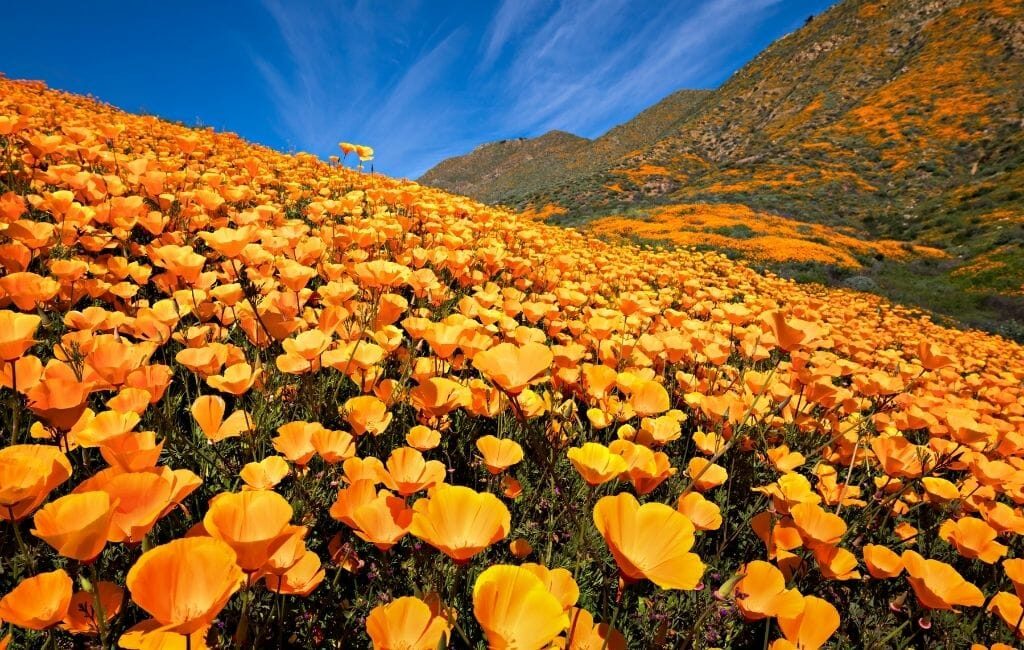
Remember to treat nature with the utmost respect. This means following California’s “Leave no trace” mantra. Take your trash when you leave. Also, don’t remove anything from the fields, and THAT includes picking the flowers.
Enjoy the California wildflower season, and let us know which Southern California destination “wowed” you most.
California Wildflowers – Where to See the Southern California Superbloom was written by Noreen Kompanik for San Diego Explorer. source









